Mental Health Examination and Screening for Nursing: A Case Study of Harry
VerifiedAdded on 2023/06/04
|11
|2104
|348
AI Summary
This article discusses the importance of mental health examination and screening in nursing, with a case study of Harry. It highlights the key factors pertaining to Harry’s screening, symptoms, and intervention strategies.
Contribute Materials
Your contribution can guide someone’s learning journey. Share your
documents today.
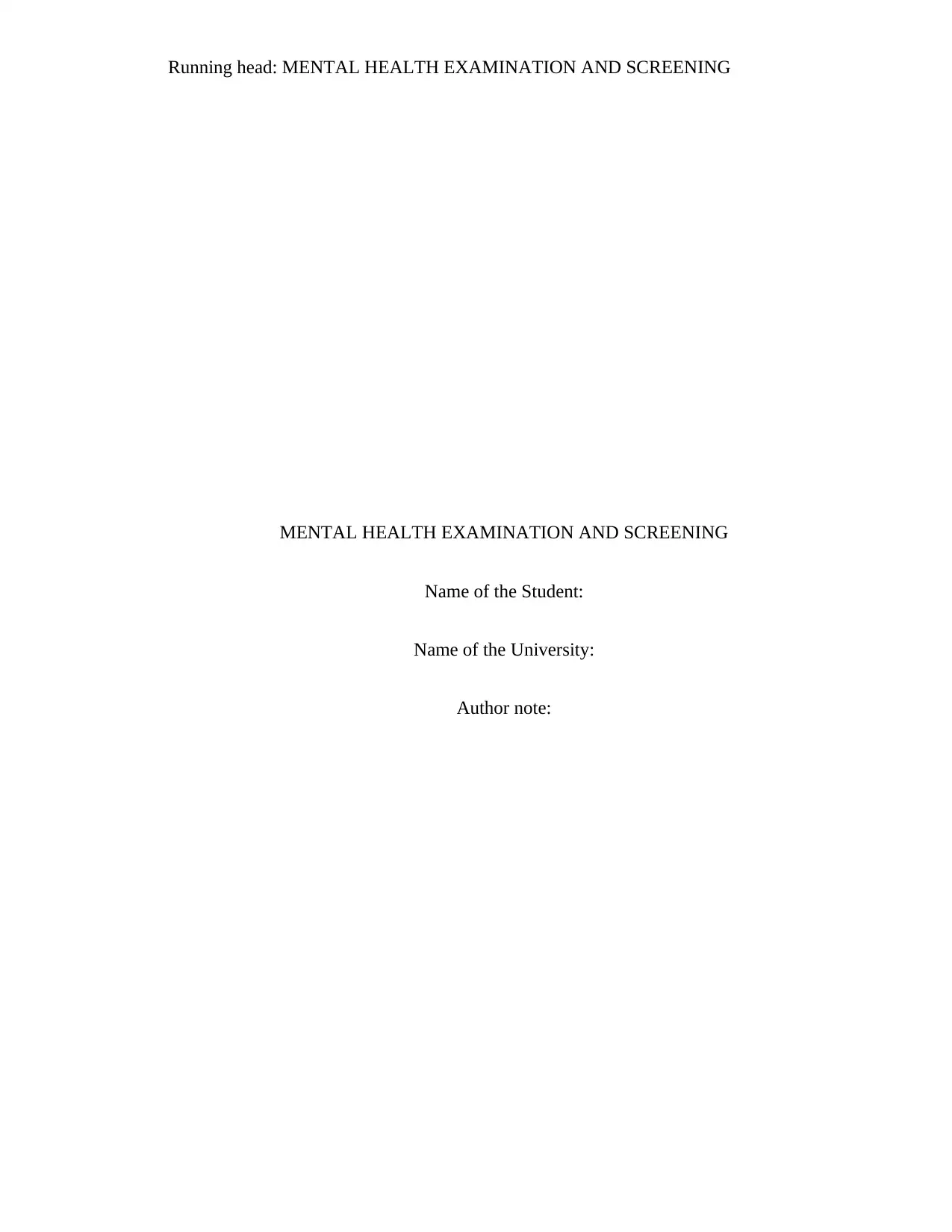
Running head: MENTAL HEALTH EXAMINATION AND SCREENING
MENTAL HEALTH EXAMINATION AND SCREENING
Name of the Student:
Name of the University:
Author note:
MENTAL HEALTH EXAMINATION AND SCREENING
Name of the Student:
Name of the University:
Author note:
Secure Best Marks with AI Grader
Need help grading? Try our AI Grader for instant feedback on your assignments.
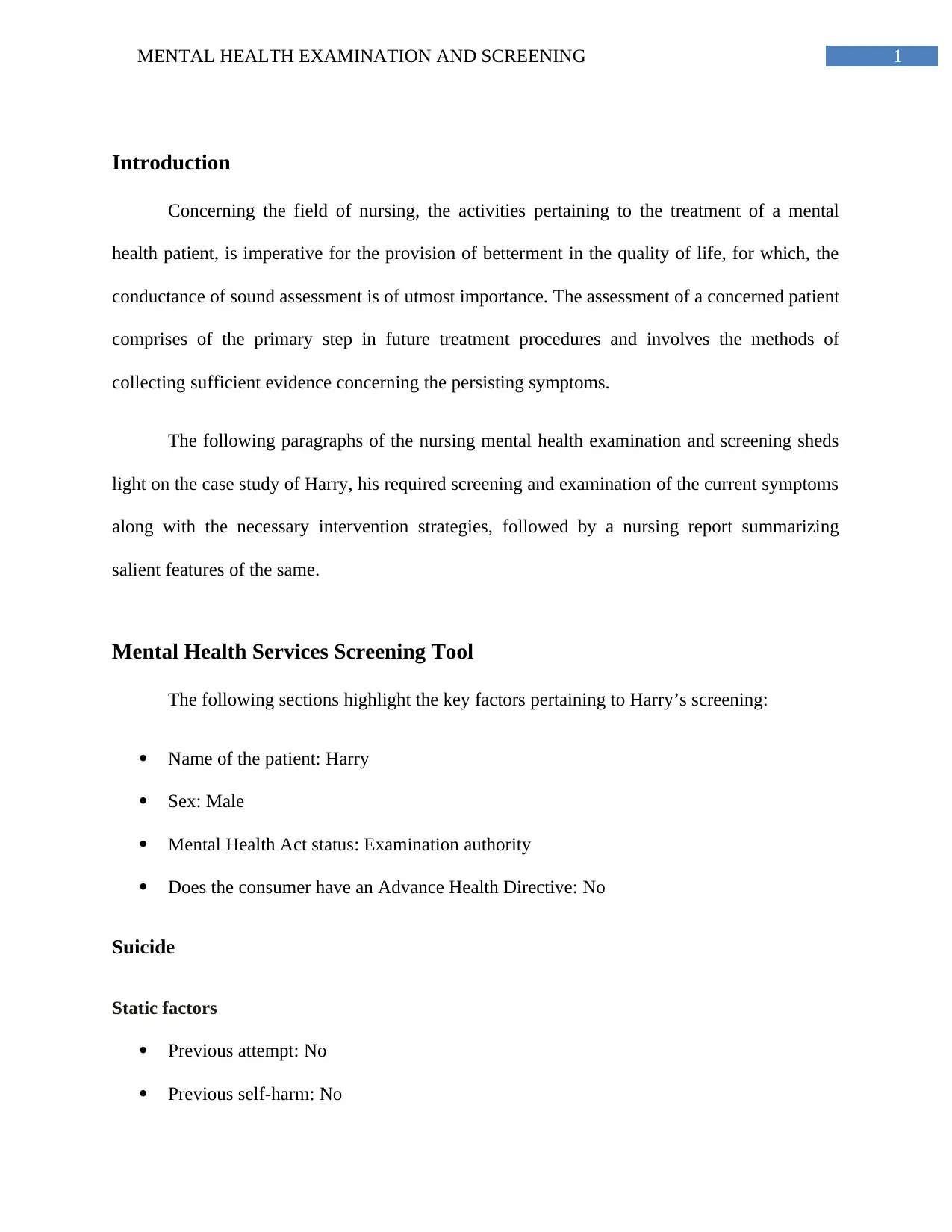
1MENTAL HEALTH EXAMINATION AND SCREENING
Introduction
Concerning the field of nursing, the activities pertaining to the treatment of a mental
health patient, is imperative for the provision of betterment in the quality of life, for which, the
conductance of sound assessment is of utmost importance. The assessment of a concerned patient
comprises of the primary step in future treatment procedures and involves the methods of
collecting sufficient evidence concerning the persisting symptoms.
The following paragraphs of the nursing mental health examination and screening sheds
light on the case study of Harry, his required screening and examination of the current symptoms
along with the necessary intervention strategies, followed by a nursing report summarizing
salient features of the same.
Mental Health Services Screening Tool
The following sections highlight the key factors pertaining to Harry’s screening:
Name of the patient: Harry
Sex: Male
Mental Health Act status: Examination authority
Does the consumer have an Advance Health Directive: No
Suicide
Static factors
Previous attempt: No
Previous self-harm: No
Introduction
Concerning the field of nursing, the activities pertaining to the treatment of a mental
health patient, is imperative for the provision of betterment in the quality of life, for which, the
conductance of sound assessment is of utmost importance. The assessment of a concerned patient
comprises of the primary step in future treatment procedures and involves the methods of
collecting sufficient evidence concerning the persisting symptoms.
The following paragraphs of the nursing mental health examination and screening sheds
light on the case study of Harry, his required screening and examination of the current symptoms
along with the necessary intervention strategies, followed by a nursing report summarizing
salient features of the same.
Mental Health Services Screening Tool
The following sections highlight the key factors pertaining to Harry’s screening:
Name of the patient: Harry
Sex: Male
Mental Health Act status: Examination authority
Does the consumer have an Advance Health Directive: No
Suicide
Static factors
Previous attempt: No
Previous self-harm: No
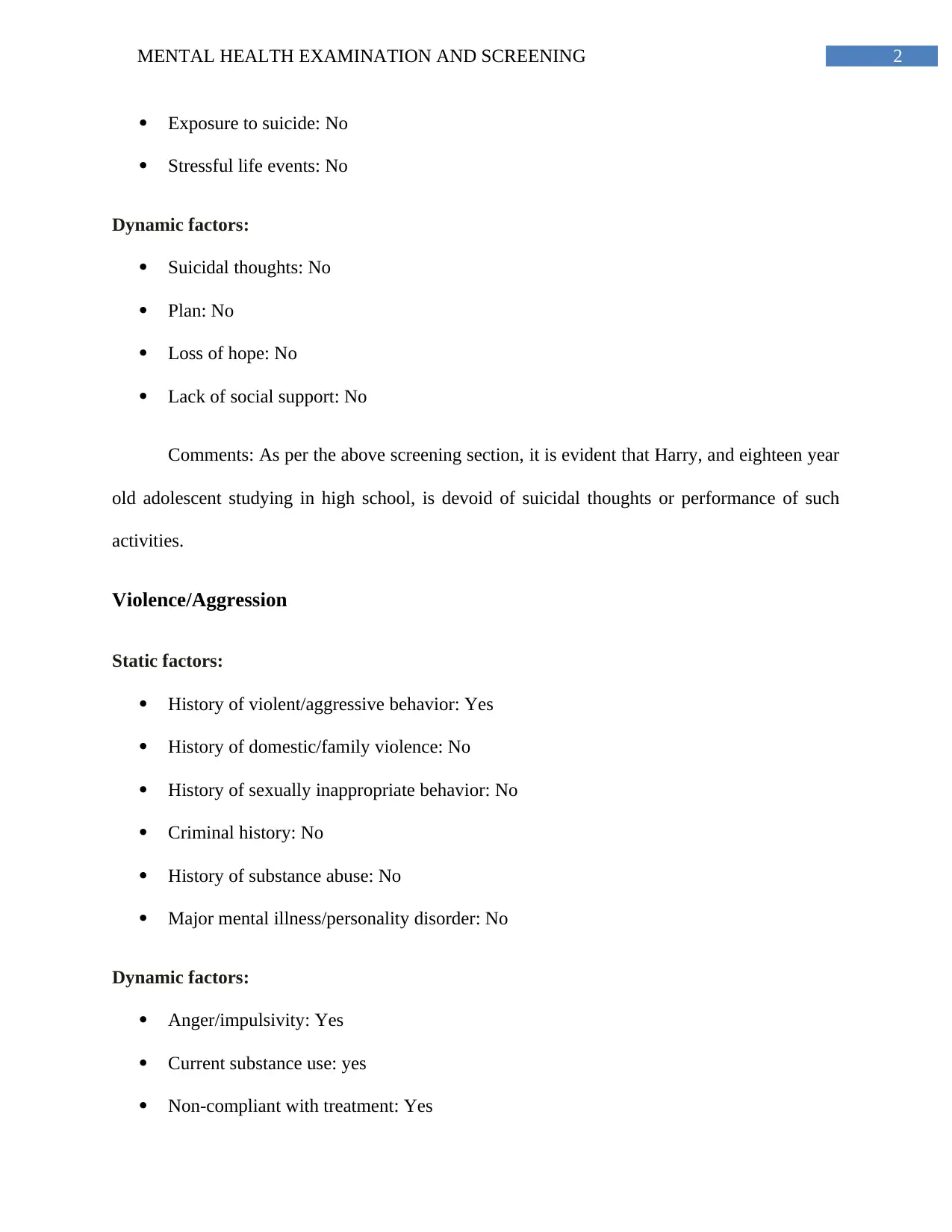
2MENTAL HEALTH EXAMINATION AND SCREENING
Exposure to suicide: No
Stressful life events: No
Dynamic factors:
Suicidal thoughts: No
Plan: No
Loss of hope: No
Lack of social support: No
Comments: As per the above screening section, it is evident that Harry, and eighteen year
old adolescent studying in high school, is devoid of suicidal thoughts or performance of such
activities.
Violence/Aggression
Static factors:
History of violent/aggressive behavior: Yes
History of domestic/family violence: No
History of sexually inappropriate behavior: No
Criminal history: No
History of substance abuse: No
Major mental illness/personality disorder: No
Dynamic factors:
Anger/impulsivity: Yes
Current substance use: yes
Non-compliant with treatment: Yes
Exposure to suicide: No
Stressful life events: No
Dynamic factors:
Suicidal thoughts: No
Plan: No
Loss of hope: No
Lack of social support: No
Comments: As per the above screening section, it is evident that Harry, and eighteen year
old adolescent studying in high school, is devoid of suicidal thoughts or performance of such
activities.
Violence/Aggression
Static factors:
History of violent/aggressive behavior: Yes
History of domestic/family violence: No
History of sexually inappropriate behavior: No
Criminal history: No
History of substance abuse: No
Major mental illness/personality disorder: No
Dynamic factors:
Anger/impulsivity: Yes
Current substance use: yes
Non-compliant with treatment: Yes

3MENTAL HEALTH EXAMINATION AND SCREENING
Violent ideation/attitudes: Yes
Psychotic symptoms: Yes
Carries weapons/access to firearms: No
Exhibits bullying behavior: No
Comments: Upon analyzing the above screening, it is evident that Harry exhibits
considerable violent behavior, without any particularly seriously reason. He is also afflicted with
delusionary symptoms of considering himself to be invisible, as well as believing that his
younger brother was necessary for his illness. He also refused to come to terms with treatment
even after admission. With examination of his family background, it seems that Harry’s
delusionary psychotic behavior is due to substance abuse of paraphernalia.
Vulnerability
Static factors:
History of trauma/abuse: No
History of domestic/family violence: No
History of financial vulnerability: No
Cognitive impairment/disability: No
Lack of family support: No
Dynamic factors:
Impaired decision-making: Yes
Sexually disinhibited: No
Self-neglect: Yes
At risk of victimization: No
Violent ideation/attitudes: Yes
Psychotic symptoms: Yes
Carries weapons/access to firearms: No
Exhibits bullying behavior: No
Comments: Upon analyzing the above screening, it is evident that Harry exhibits
considerable violent behavior, without any particularly seriously reason. He is also afflicted with
delusionary symptoms of considering himself to be invisible, as well as believing that his
younger brother was necessary for his illness. He also refused to come to terms with treatment
even after admission. With examination of his family background, it seems that Harry’s
delusionary psychotic behavior is due to substance abuse of paraphernalia.
Vulnerability
Static factors:
History of trauma/abuse: No
History of domestic/family violence: No
History of financial vulnerability: No
Cognitive impairment/disability: No
Lack of family support: No
Dynamic factors:
Impaired decision-making: Yes
Sexually disinhibited: No
Self-neglect: Yes
At risk of victimization: No
Secure Best Marks with AI Grader
Need help grading? Try our AI Grader for instant feedback on your assignments.
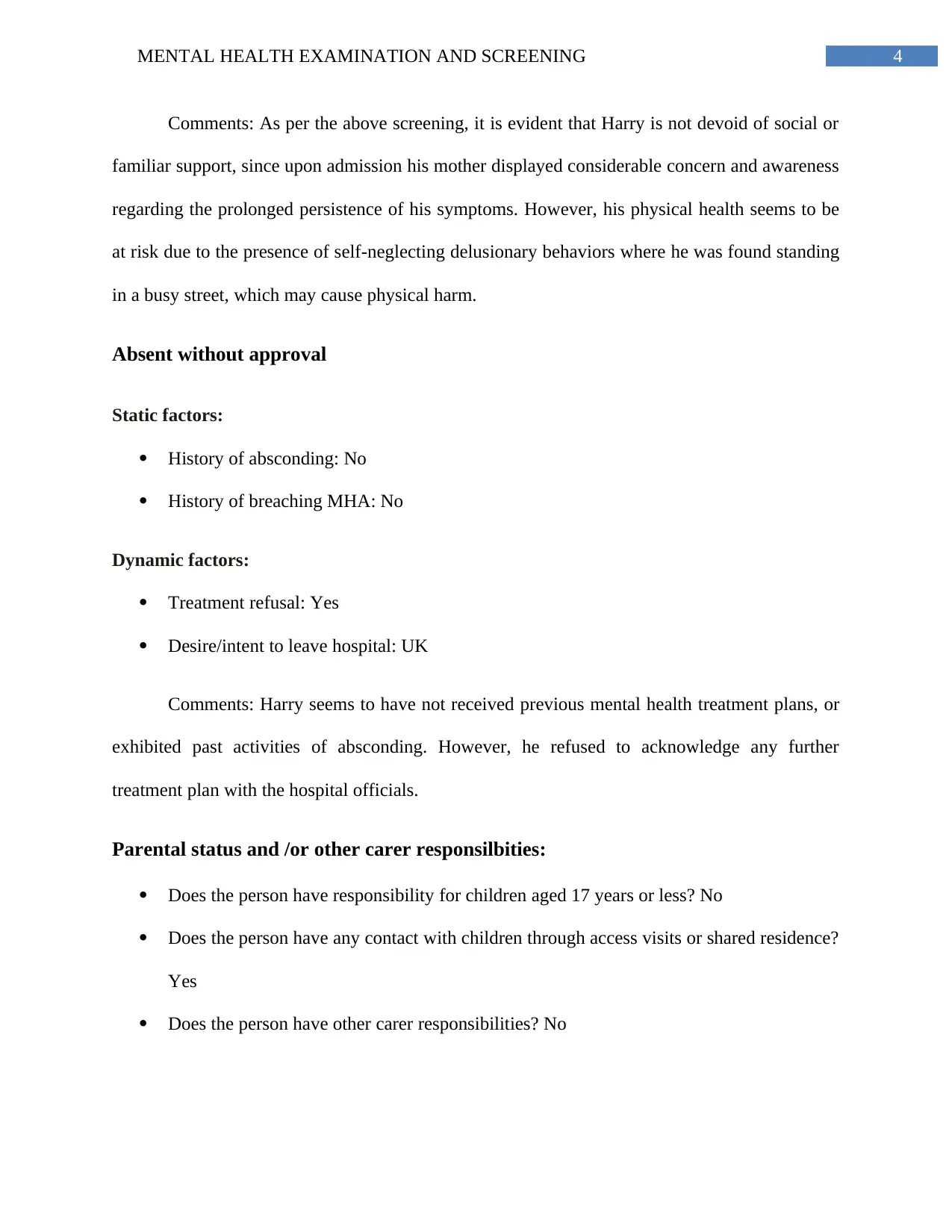
4MENTAL HEALTH EXAMINATION AND SCREENING
Comments: As per the above screening, it is evident that Harry is not devoid of social or
familiar support, since upon admission his mother displayed considerable concern and awareness
regarding the prolonged persistence of his symptoms. However, his physical health seems to be
at risk due to the presence of self-neglecting delusionary behaviors where he was found standing
in a busy street, which may cause physical harm.
Absent without approval
Static factors:
History of absconding: No
History of breaching MHA: No
Dynamic factors:
Treatment refusal: Yes
Desire/intent to leave hospital: UK
Comments: Harry seems to have not received previous mental health treatment plans, or
exhibited past activities of absconding. However, he refused to acknowledge any further
treatment plan with the hospital officials.
Parental status and /or other carer responsilbities:
Does the person have responsibility for children aged 17 years or less? No
Does the person have any contact with children through access visits or shared residence?
Yes
Does the person have other carer responsibilities? No
Comments: As per the above screening, it is evident that Harry is not devoid of social or
familiar support, since upon admission his mother displayed considerable concern and awareness
regarding the prolonged persistence of his symptoms. However, his physical health seems to be
at risk due to the presence of self-neglecting delusionary behaviors where he was found standing
in a busy street, which may cause physical harm.
Absent without approval
Static factors:
History of absconding: No
History of breaching MHA: No
Dynamic factors:
Treatment refusal: Yes
Desire/intent to leave hospital: UK
Comments: Harry seems to have not received previous mental health treatment plans, or
exhibited past activities of absconding. However, he refused to acknowledge any further
treatment plan with the hospital officials.
Parental status and /or other carer responsilbities:
Does the person have responsibility for children aged 17 years or less? No
Does the person have any contact with children through access visits or shared residence?
Yes
Does the person have other carer responsibilities? No

5MENTAL HEALTH EXAMINATION AND SCREENING
Protective factors: Harry does not own the responsibility of any minor. However, he lives
in contact with his younger brother, with whom he seems to be skeptical.
Overall assessment of risk and plans to mitigate risk:
Overview/Impression:
Person’s level of risk appears to be highly changeable: Yes
There are factors that contribute to uncertainty regarding screen: Yes
A more comprehensive risk assessment is required; Yes
Mental State Examination Tool
General appearance The patient appears to often remain silent and
submissive, followed by sudden onsets of
excitability.
Behavior Patient tends to exhibit fluctuating behaviors, upon
being silent and melancholic and then switching to
aggressive violent behaviors for no specific reason.
Speech Patient display normal speech, with however,
hysterical modes of screaming and laughing during
exhibition of violent, defiant behavior.
Mood and effect Patient presents fluctuating moods of violence and
submission.
Thought process The patient is afflicted by delusionary and
behaviors of paranoia where he believes that he is
invisible and his younger is the cause behind his
suffering.
Thought content The patients thought process seems to be psychotic
and delusional, as he was found in busy street with
the confidence that he his invisible. He further
engages in thoughts of paranoia where he perceives
his younger brother to be the culprit behind his
illness.
Perception The patient exhibits distorted perception as evident
from his conception, concerning his abilities to be
invisible.
Cognition The patient exhibited significant decline in
cognition, as reported by his mother concerning his
detrimental performance in academics and social
interaction.
Judgment The patient’s judgment seems to be distorted as
Protective factors: Harry does not own the responsibility of any minor. However, he lives
in contact with his younger brother, with whom he seems to be skeptical.
Overall assessment of risk and plans to mitigate risk:
Overview/Impression:
Person’s level of risk appears to be highly changeable: Yes
There are factors that contribute to uncertainty regarding screen: Yes
A more comprehensive risk assessment is required; Yes
Mental State Examination Tool
General appearance The patient appears to often remain silent and
submissive, followed by sudden onsets of
excitability.
Behavior Patient tends to exhibit fluctuating behaviors, upon
being silent and melancholic and then switching to
aggressive violent behaviors for no specific reason.
Speech Patient display normal speech, with however,
hysterical modes of screaming and laughing during
exhibition of violent, defiant behavior.
Mood and effect Patient presents fluctuating moods of violence and
submission.
Thought process The patient is afflicted by delusionary and
behaviors of paranoia where he believes that he is
invisible and his younger is the cause behind his
suffering.
Thought content The patients thought process seems to be psychotic
and delusional, as he was found in busy street with
the confidence that he his invisible. He further
engages in thoughts of paranoia where he perceives
his younger brother to be the culprit behind his
illness.
Perception The patient exhibits distorted perception as evident
from his conception, concerning his abilities to be
invisible.
Cognition The patient exhibited significant decline in
cognition, as reported by his mother concerning his
detrimental performance in academics and social
interaction.
Judgment The patient’s judgment seems to be distorted as
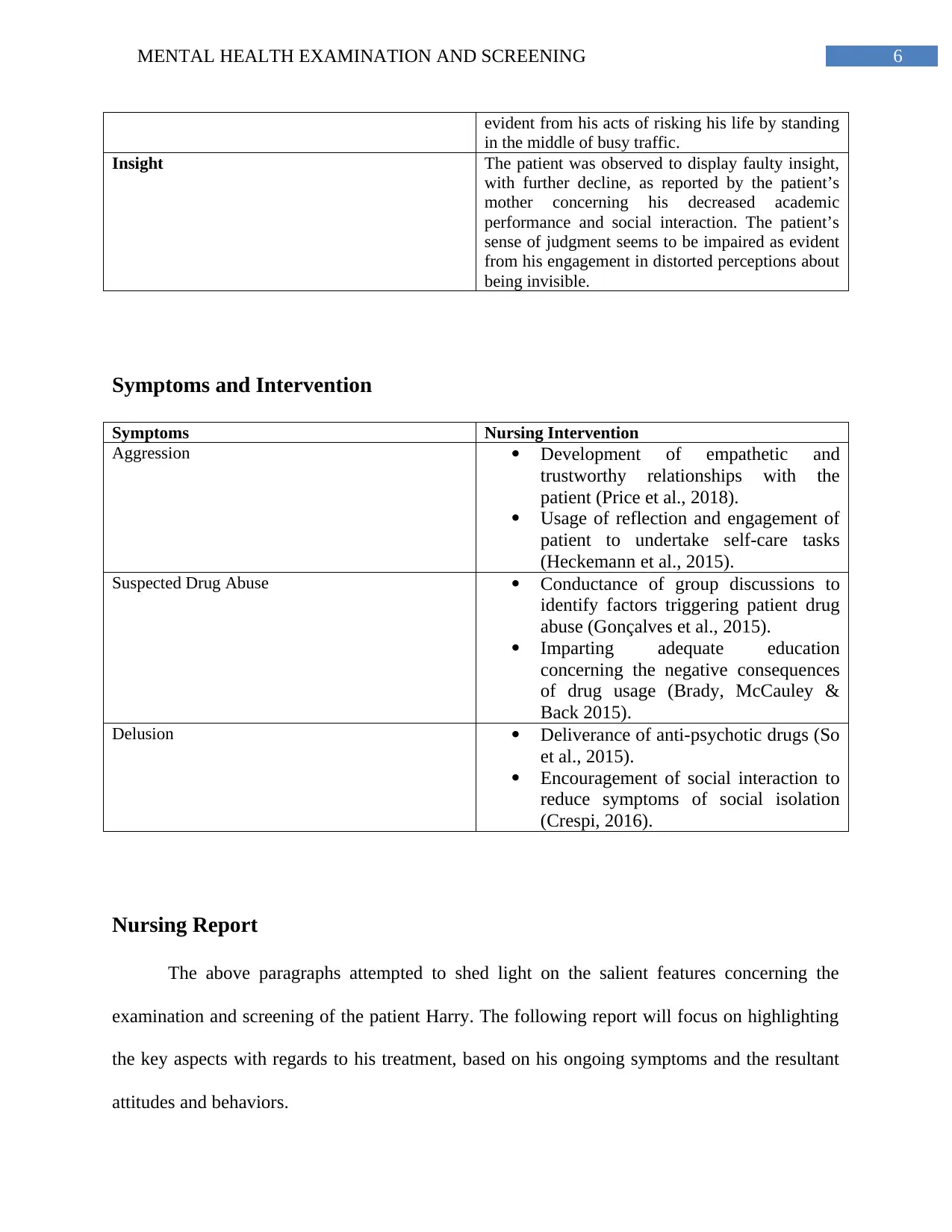
6MENTAL HEALTH EXAMINATION AND SCREENING
evident from his acts of risking his life by standing
in the middle of busy traffic.
Insight The patient was observed to display faulty insight,
with further decline, as reported by the patient’s
mother concerning his decreased academic
performance and social interaction. The patient’s
sense of judgment seems to be impaired as evident
from his engagement in distorted perceptions about
being invisible.
Symptoms and Intervention
Symptoms Nursing Intervention
Aggression Development of empathetic and
trustworthy relationships with the
patient (Price et al., 2018).
Usage of reflection and engagement of
patient to undertake self-care tasks
(Heckemann et al., 2015).
Suspected Drug Abuse Conductance of group discussions to
identify factors triggering patient drug
abuse (Gonçalves et al., 2015).
Imparting adequate education
concerning the negative consequences
of drug usage (Brady, McCauley &
Back 2015).
Delusion Deliverance of anti-psychotic drugs (So
et al., 2015).
Encouragement of social interaction to
reduce symptoms of social isolation
(Crespi, 2016).
Nursing Report
The above paragraphs attempted to shed light on the salient features concerning the
examination and screening of the patient Harry. The following report will focus on highlighting
the key aspects with regards to his treatment, based on his ongoing symptoms and the resultant
attitudes and behaviors.
evident from his acts of risking his life by standing
in the middle of busy traffic.
Insight The patient was observed to display faulty insight,
with further decline, as reported by the patient’s
mother concerning his decreased academic
performance and social interaction. The patient’s
sense of judgment seems to be impaired as evident
from his engagement in distorted perceptions about
being invisible.
Symptoms and Intervention
Symptoms Nursing Intervention
Aggression Development of empathetic and
trustworthy relationships with the
patient (Price et al., 2018).
Usage of reflection and engagement of
patient to undertake self-care tasks
(Heckemann et al., 2015).
Suspected Drug Abuse Conductance of group discussions to
identify factors triggering patient drug
abuse (Gonçalves et al., 2015).
Imparting adequate education
concerning the negative consequences
of drug usage (Brady, McCauley &
Back 2015).
Delusion Deliverance of anti-psychotic drugs (So
et al., 2015).
Encouragement of social interaction to
reduce symptoms of social isolation
(Crespi, 2016).
Nursing Report
The above paragraphs attempted to shed light on the salient features concerning the
examination and screening of the patient Harry. The following report will focus on highlighting
the key aspects with regards to his treatment, based on his ongoing symptoms and the resultant
attitudes and behaviors.
Paraphrase This Document
Need a fresh take? Get an instant paraphrase of this document with our AI Paraphraser

7MENTAL HEALTH EXAMINATION AND SCREENING
Concerning the situation in which Harry was uncovered, it is evident that he is displaying
psychotic, delusionary behaviors, which is evident from his preconceived notion of considering
himself to be invisible and a result, free from harm. Due to these considerations, Harry will be
susceptible to displaying behaviors pertaining to self-harm, which may prove to be fatal for his
optimum health and survival in the near future. Despite the absence of self-destructive suicidal
behaviors, Harry also seems to engage in feelings of mistrust and paranoia, as evident from his
consideration of his younger sibling as a potential threat to his health and fitness. Ironically,
Harry is not devoid of familial support, as observed from the behaviors presented by his mother
who not only seemed concerned, but also adequately aware of his detrimental mental health,
further suspecting him to engage in drug abuse. As observed upon hospital admission, as well as
reported by his mother, Harry presents fluctuating behaviors of being silent and sudden
exhibition of violently aggressive behaviors, which may be as a result of his suspected drug
abuse. Hence, a further detailed screening, examination and treatment plan is required, in order
to identify extensively, the causative triggers pertaining to Harry’s conductance of drug abuse
and violent attitudes.
The activities and intervention strategies of the nurse are key factors pertaining to the
provision of an adequate patient treatment plan. With regards to Harry, the nurse may be
required to deliver appropriate anti-psychotic drugs, in order to reduce his symptoms of delusion.
Concerning the patient’s tendency to engage in social isolation, there is need for adequate
encouragement to partake in social interaction, where Harry will be allowed to express his
underlying thoughts and insecurities. The nurse may intervene for mitigation of suspected drug
abuse through the usage of empathetic and considerate behaviors with the patient. The nurse may
also activate encourage Harry to participate in group activities where the he may gradually
Concerning the situation in which Harry was uncovered, it is evident that he is displaying
psychotic, delusionary behaviors, which is evident from his preconceived notion of considering
himself to be invisible and a result, free from harm. Due to these considerations, Harry will be
susceptible to displaying behaviors pertaining to self-harm, which may prove to be fatal for his
optimum health and survival in the near future. Despite the absence of self-destructive suicidal
behaviors, Harry also seems to engage in feelings of mistrust and paranoia, as evident from his
consideration of his younger sibling as a potential threat to his health and fitness. Ironically,
Harry is not devoid of familial support, as observed from the behaviors presented by his mother
who not only seemed concerned, but also adequately aware of his detrimental mental health,
further suspecting him to engage in drug abuse. As observed upon hospital admission, as well as
reported by his mother, Harry presents fluctuating behaviors of being silent and sudden
exhibition of violently aggressive behaviors, which may be as a result of his suspected drug
abuse. Hence, a further detailed screening, examination and treatment plan is required, in order
to identify extensively, the causative triggers pertaining to Harry’s conductance of drug abuse
and violent attitudes.
The activities and intervention strategies of the nurse are key factors pertaining to the
provision of an adequate patient treatment plan. With regards to Harry, the nurse may be
required to deliver appropriate anti-psychotic drugs, in order to reduce his symptoms of delusion.
Concerning the patient’s tendency to engage in social isolation, there is need for adequate
encouragement to partake in social interaction, where Harry will be allowed to express his
underlying thoughts and insecurities. The nurse may intervene for mitigation of suspected drug
abuse through the usage of empathetic and considerate behaviors with the patient. The nurse may
also activate encourage Harry to participate in group activities where the he may gradually
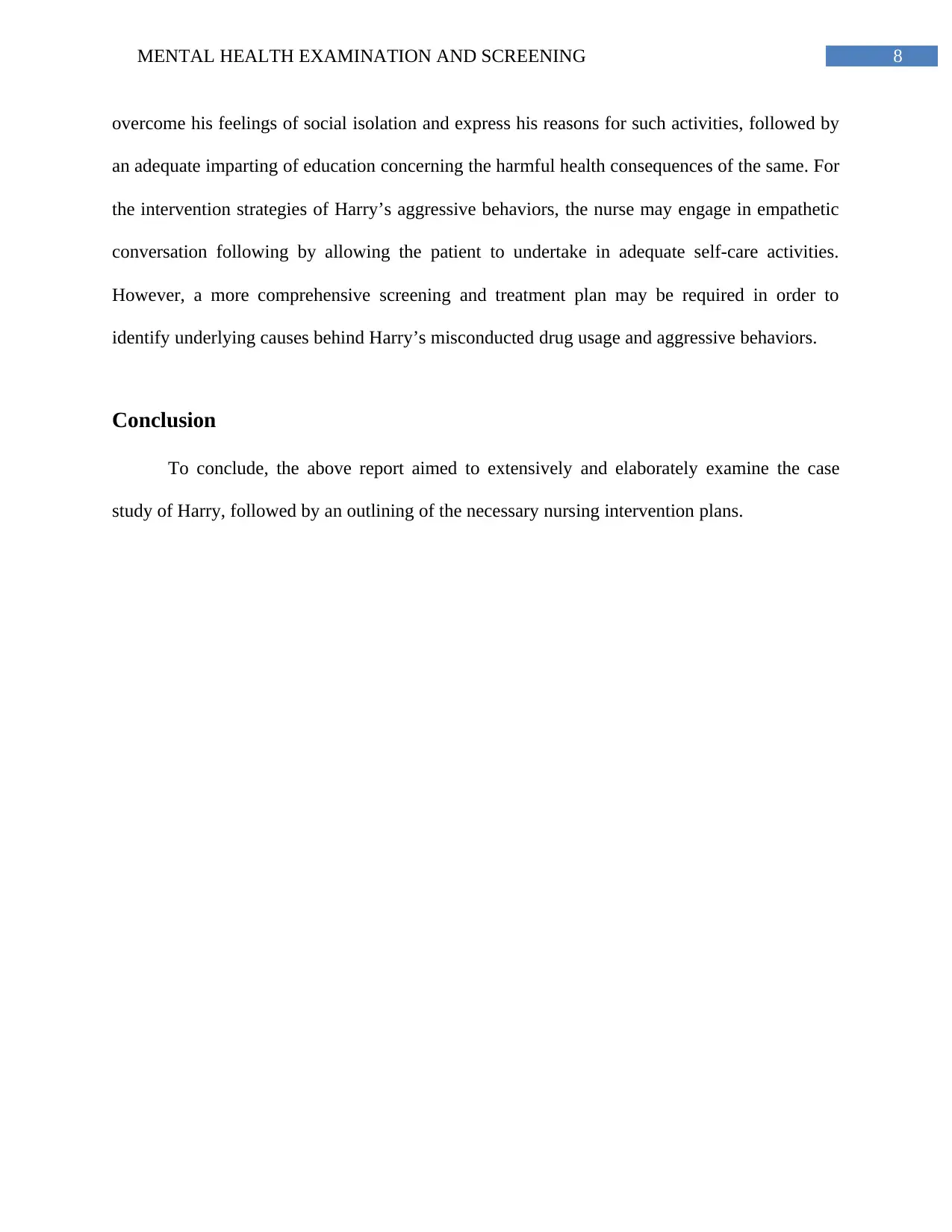
8MENTAL HEALTH EXAMINATION AND SCREENING
overcome his feelings of social isolation and express his reasons for such activities, followed by
an adequate imparting of education concerning the harmful health consequences of the same. For
the intervention strategies of Harry’s aggressive behaviors, the nurse may engage in empathetic
conversation following by allowing the patient to undertake in adequate self-care activities.
However, a more comprehensive screening and treatment plan may be required in order to
identify underlying causes behind Harry’s misconducted drug usage and aggressive behaviors.
Conclusion
To conclude, the above report aimed to extensively and elaborately examine the case
study of Harry, followed by an outlining of the necessary nursing intervention plans.
overcome his feelings of social isolation and express his reasons for such activities, followed by
an adequate imparting of education concerning the harmful health consequences of the same. For
the intervention strategies of Harry’s aggressive behaviors, the nurse may engage in empathetic
conversation following by allowing the patient to undertake in adequate self-care activities.
However, a more comprehensive screening and treatment plan may be required in order to
identify underlying causes behind Harry’s misconducted drug usage and aggressive behaviors.
Conclusion
To conclude, the above report aimed to extensively and elaborately examine the case
study of Harry, followed by an outlining of the necessary nursing intervention plans.

9MENTAL HEALTH EXAMINATION AND SCREENING
References
Brady, K. T., McCauley, J. L., & Back, S. E. (2015). Prescription opioid misuse, abuse, and
treatment in the United States: an update. American Journal of Psychiatry, 173(1), 18-26.
Crespi, B. J. (2016). Oxytocin, testosterone, and human social cognition. Biological
Reviews, 91(2), 390-408.
Gonçalves, J. P., Lucchetti, G., Menezes, P. R., & Vallada, H. (2015). Religious and spiritual
interventions in mental health care: a systematic review and meta-analysis of randomized
controlled clinical trials. Psychological medicine, 45(14), 2937-2949.
Heckemann, B., Zeller, A., Hahn, S., Dassen, T., Schols, J. M. G. A., & Halfens, R. J. G. (2015).
The effect of aggression management training programmes for nursing staff and students
working in an acute hospital setting. A narrative review of current literature. Nurse
education today, 35(1), 212-219.
Price, O., Baker, J., Bee, P., Grundy, A., Scott, A., Butler, D., ... & Lovell, K. (2018). Patient
perspectives on barriers and enablers to the use and effectiveness of de‐escalation
techniques for the management of violence and aggression in mental health
settings. Journal of advanced nursing, 74(3), 614-625.
So, S. H., Peters, E. R., Kapur, S., & Garety, P. A. (2015). Changes in delusional dimensions and
emotions over eight weeks of antipsychotic treatment in acute patients. Psychiatry
research, 228(3), 393-398.
References
Brady, K. T., McCauley, J. L., & Back, S. E. (2015). Prescription opioid misuse, abuse, and
treatment in the United States: an update. American Journal of Psychiatry, 173(1), 18-26.
Crespi, B. J. (2016). Oxytocin, testosterone, and human social cognition. Biological
Reviews, 91(2), 390-408.
Gonçalves, J. P., Lucchetti, G., Menezes, P. R., & Vallada, H. (2015). Religious and spiritual
interventions in mental health care: a systematic review and meta-analysis of randomized
controlled clinical trials. Psychological medicine, 45(14), 2937-2949.
Heckemann, B., Zeller, A., Hahn, S., Dassen, T., Schols, J. M. G. A., & Halfens, R. J. G. (2015).
The effect of aggression management training programmes for nursing staff and students
working in an acute hospital setting. A narrative review of current literature. Nurse
education today, 35(1), 212-219.
Price, O., Baker, J., Bee, P., Grundy, A., Scott, A., Butler, D., ... & Lovell, K. (2018). Patient
perspectives on barriers and enablers to the use and effectiveness of de‐escalation
techniques for the management of violence and aggression in mental health
settings. Journal of advanced nursing, 74(3), 614-625.
So, S. H., Peters, E. R., Kapur, S., & Garety, P. A. (2015). Changes in delusional dimensions and
emotions over eight weeks of antipsychotic treatment in acute patients. Psychiatry
research, 228(3), 393-398.
Secure Best Marks with AI Grader
Need help grading? Try our AI Grader for instant feedback on your assignments.

10MENTAL HEALTH EXAMINATION AND SCREENING
1 out of 11
Related Documents
Your All-in-One AI-Powered Toolkit for Academic Success.
+13062052269
info@desklib.com
Available 24*7 on WhatsApp / Email
![[object Object]](/_next/static/media/star-bottom.7253800d.svg)
Unlock your academic potential
© 2024 | Zucol Services PVT LTD | All rights reserved.





